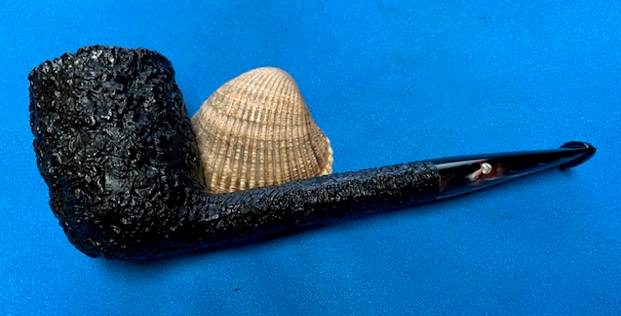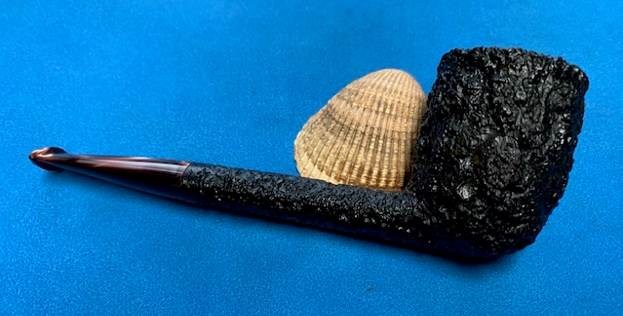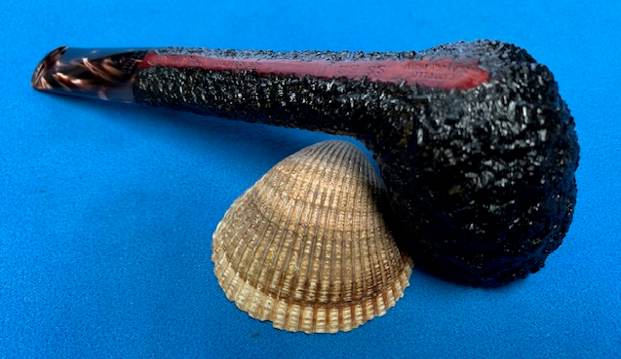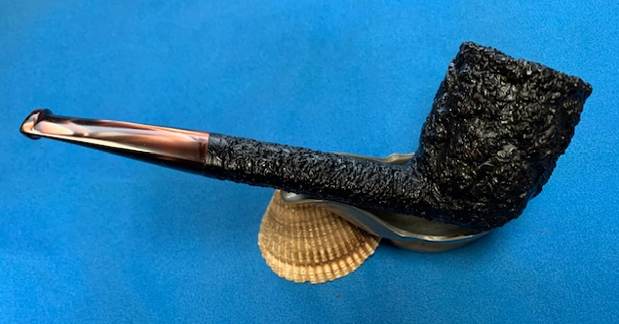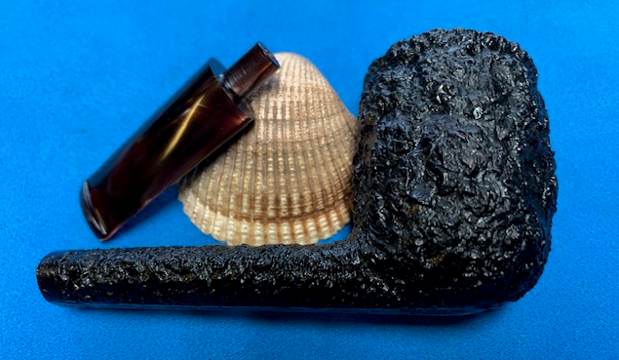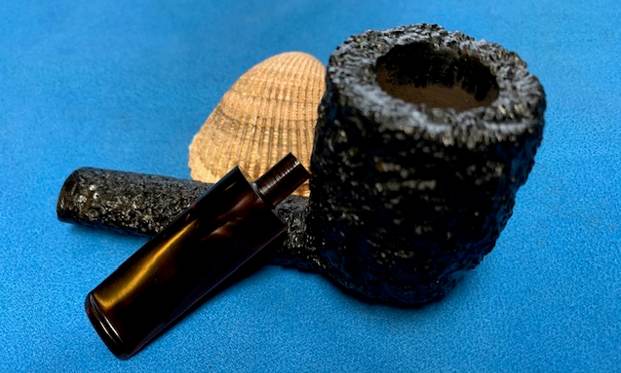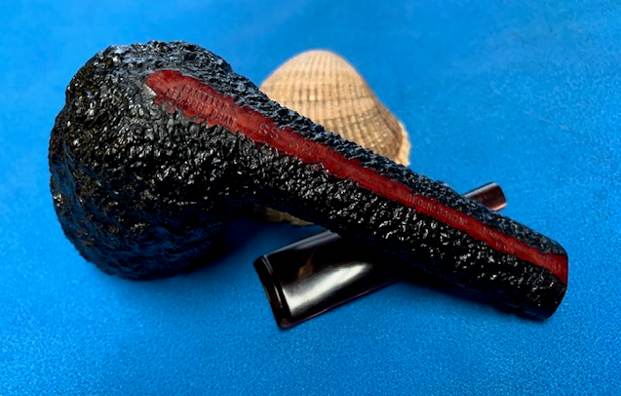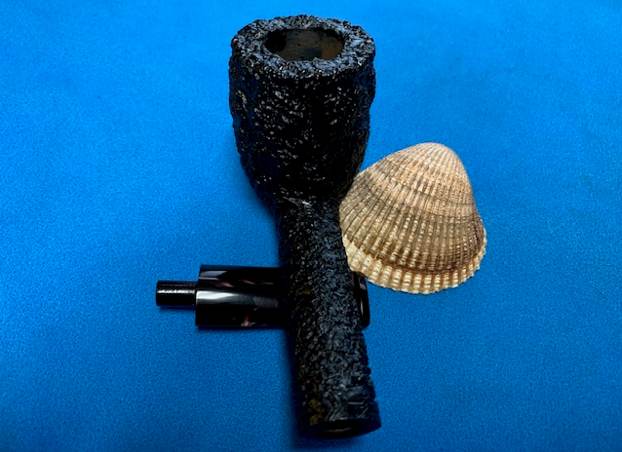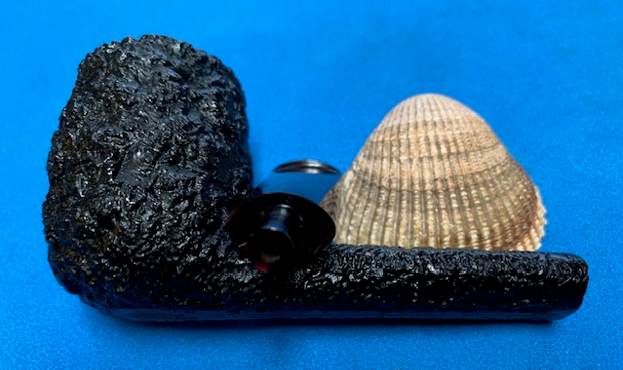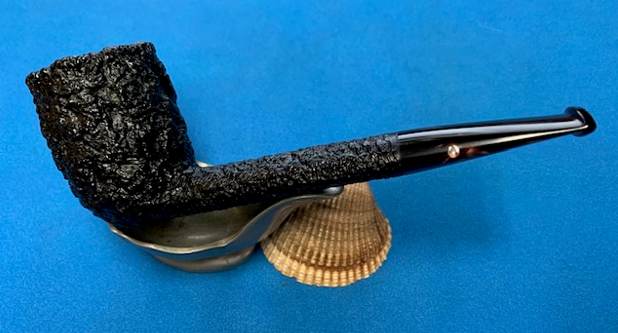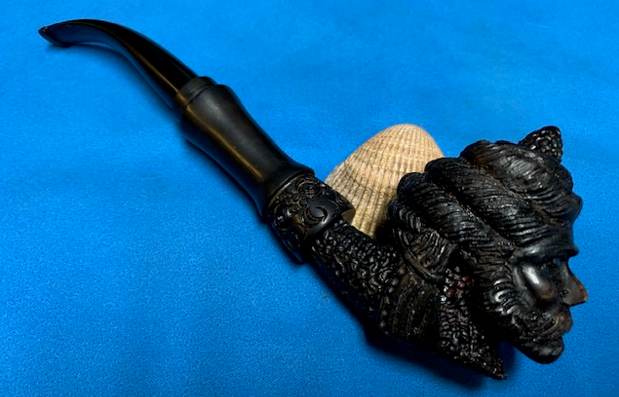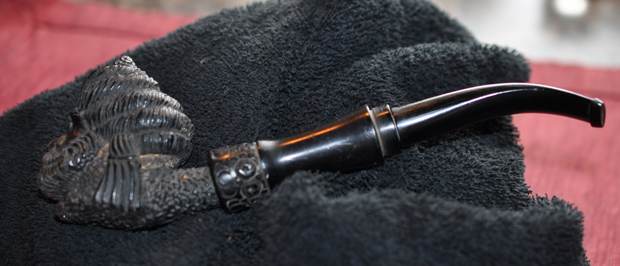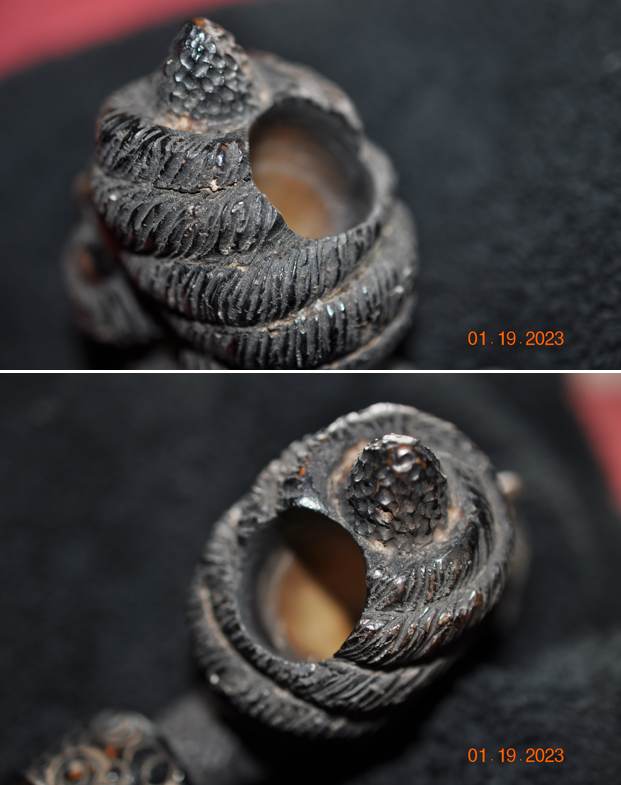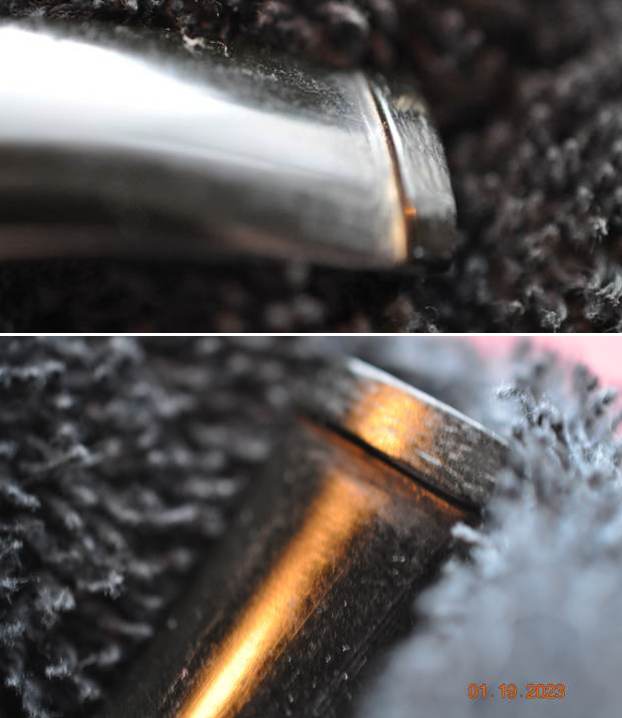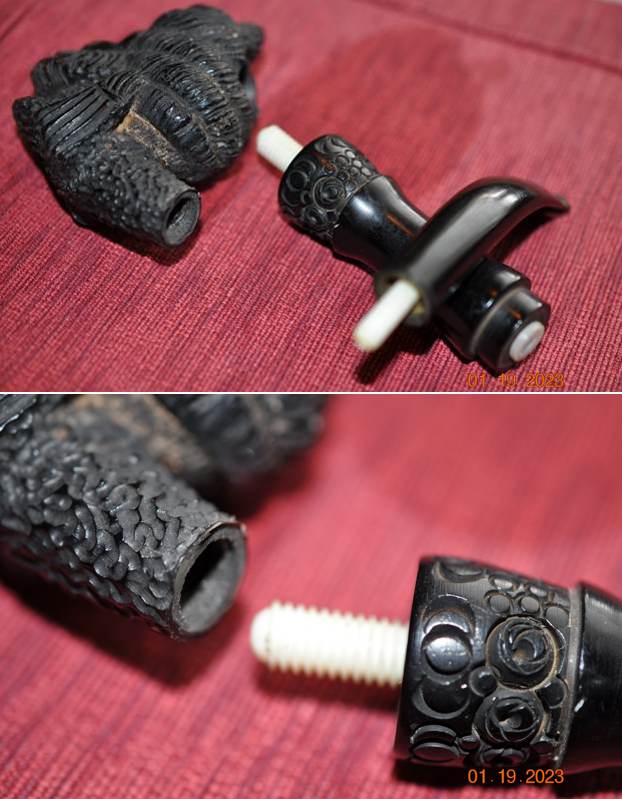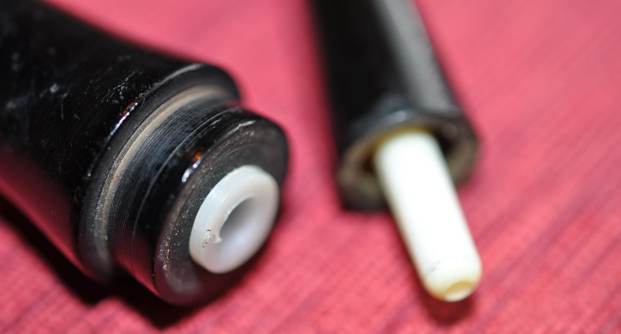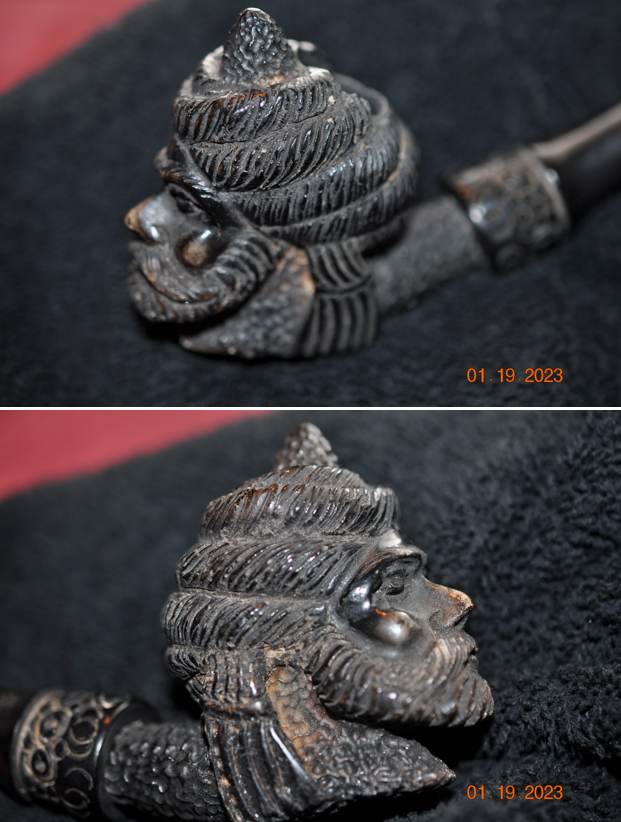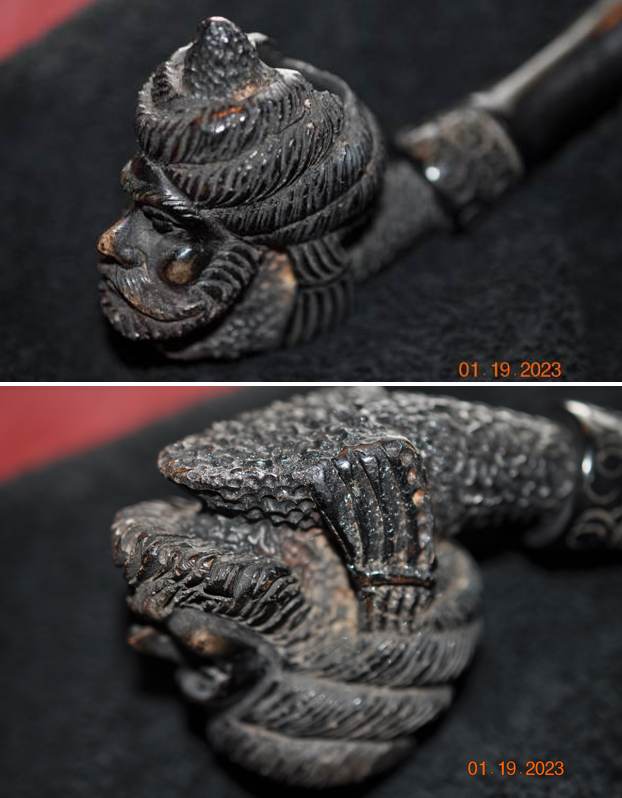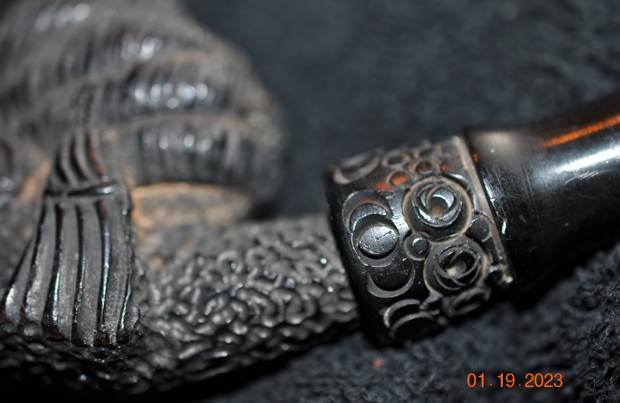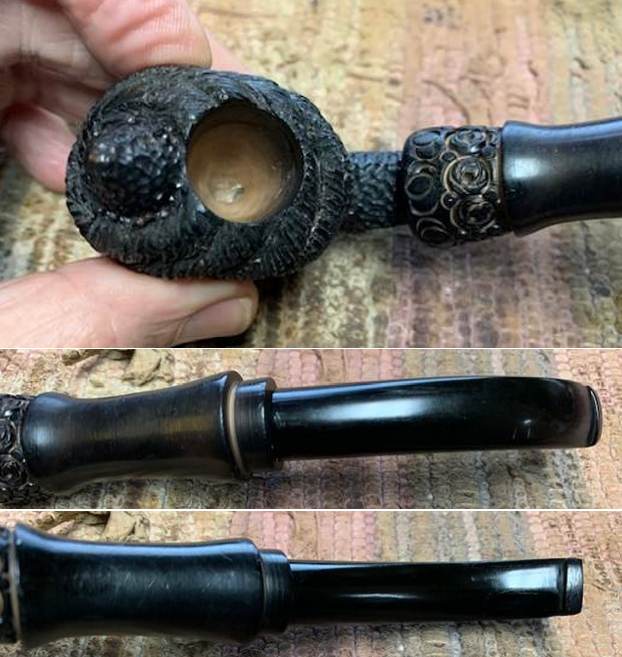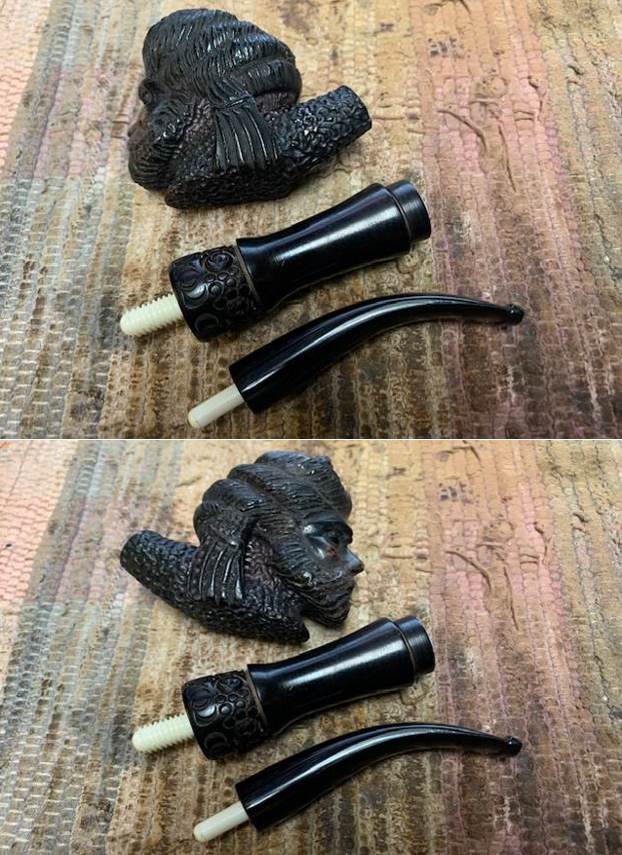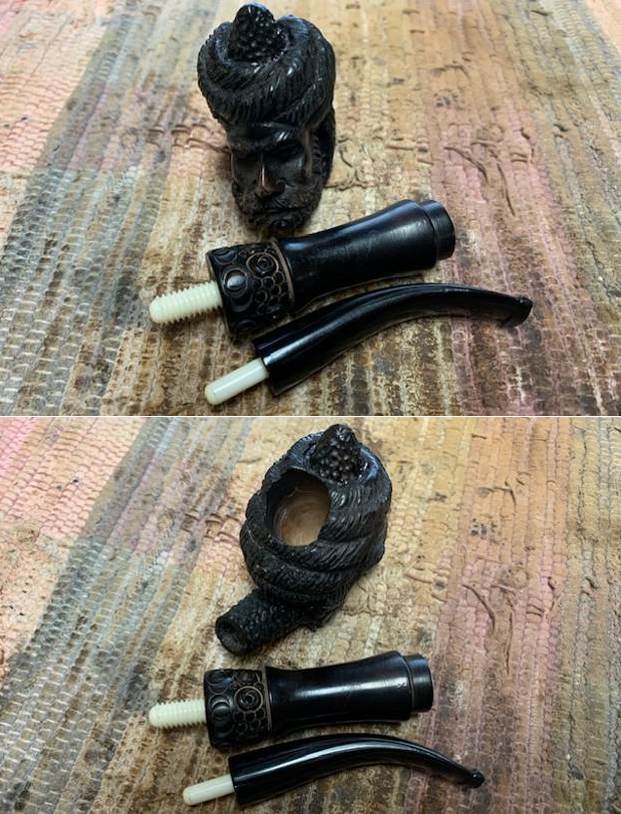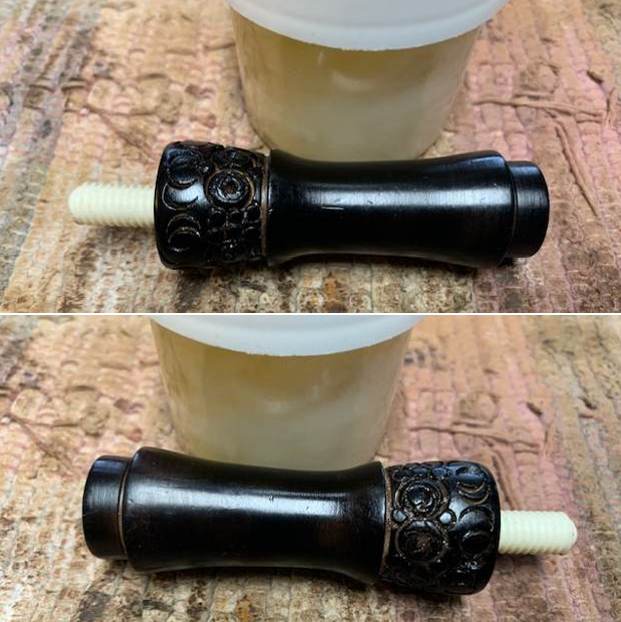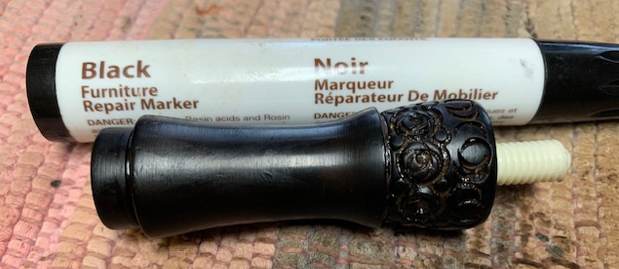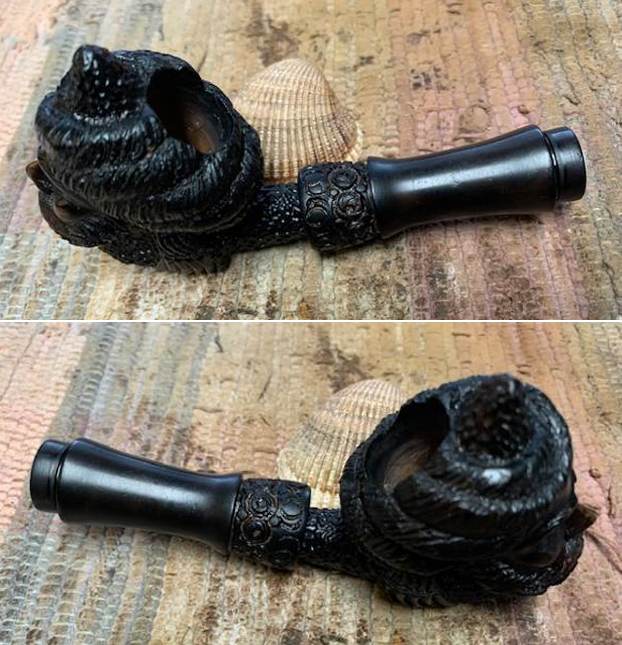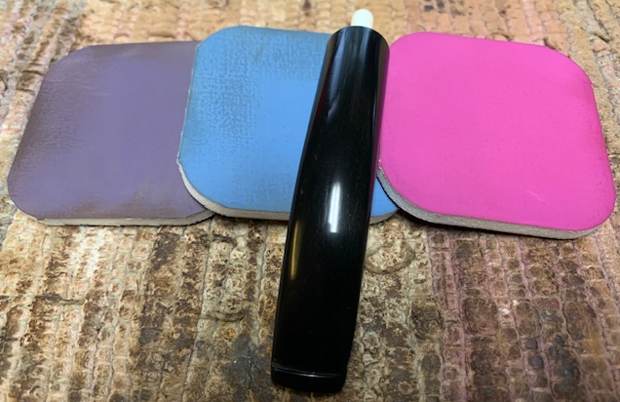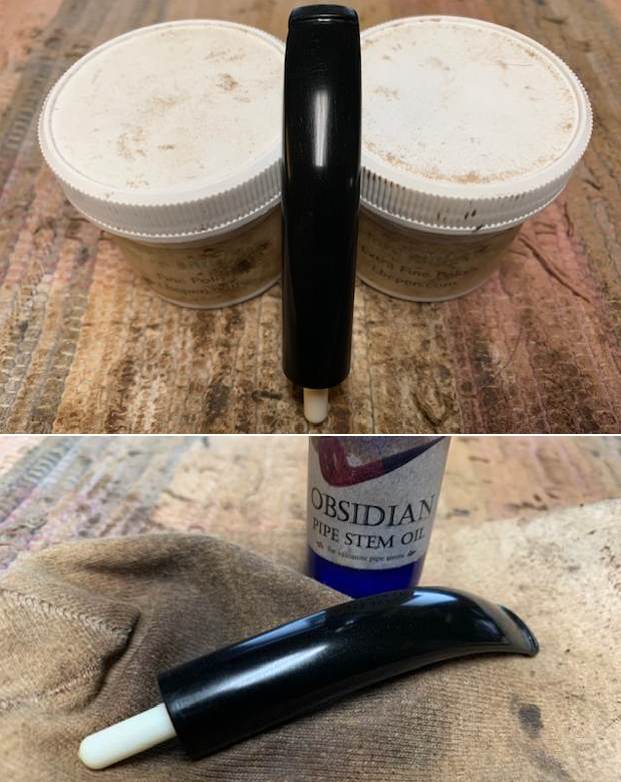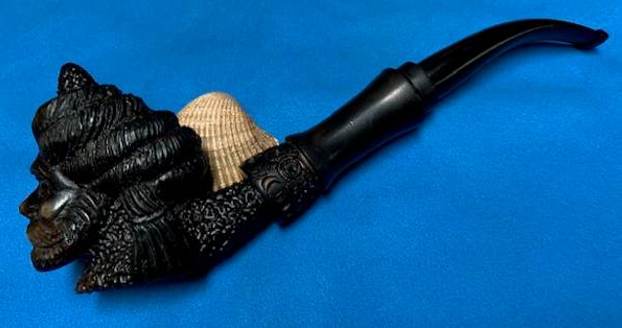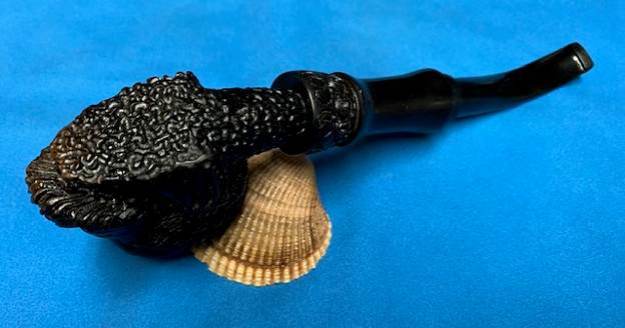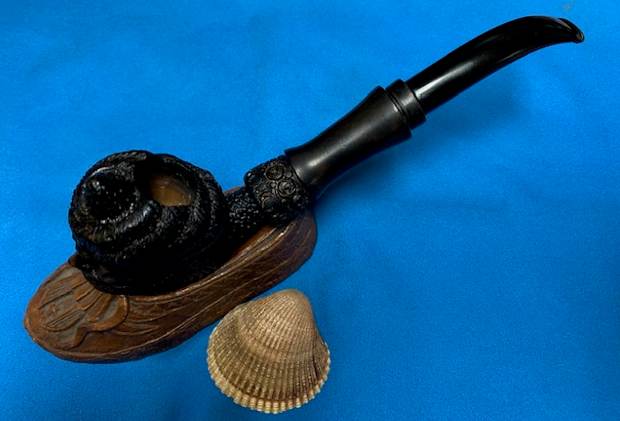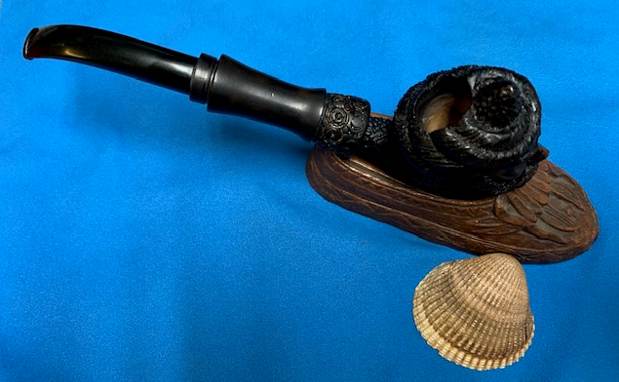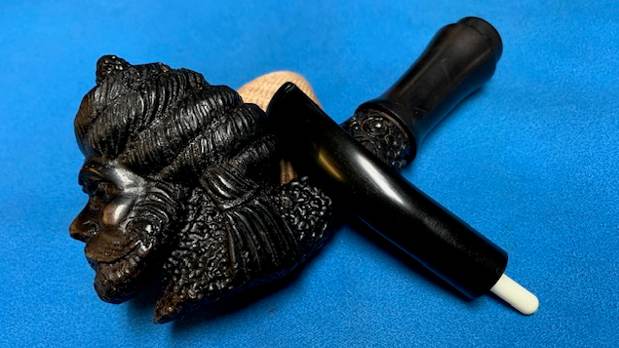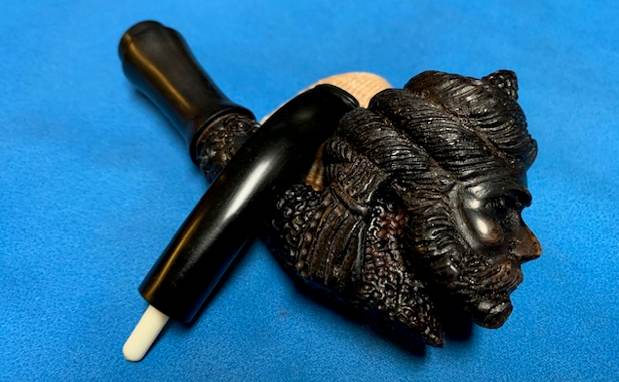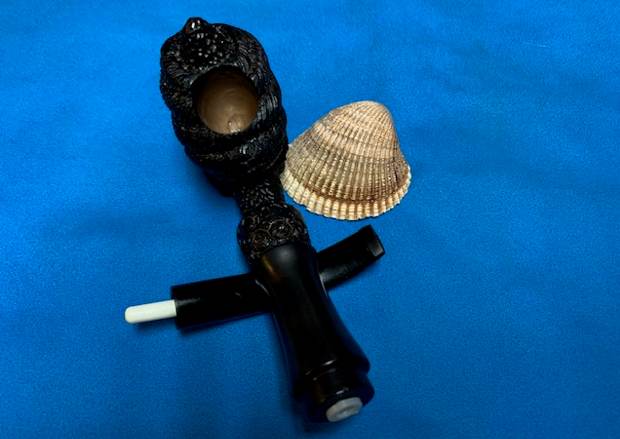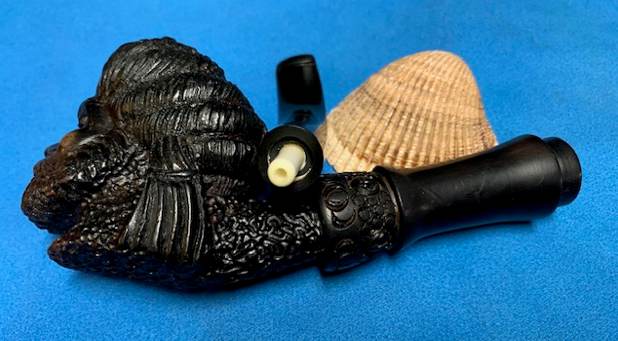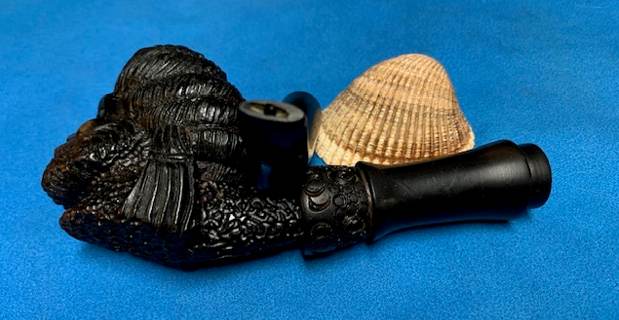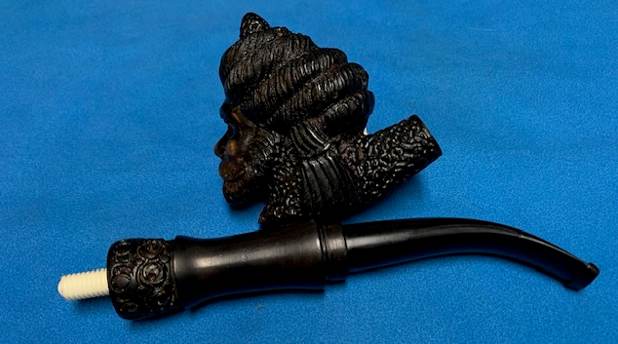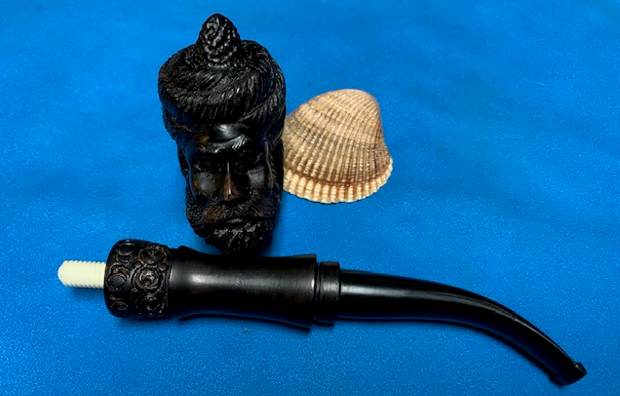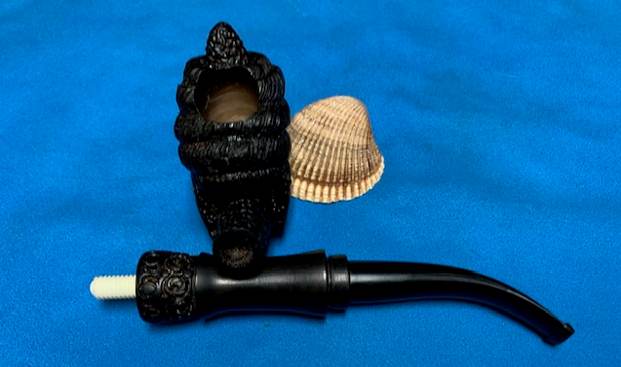Blog by Steve Laug
The next pipe I have chosen to work on is a nice looking rusticated Castello Canadian that I picked up in a lot of 10 pipes from a fellow on Vancouver Island who was selling his collection. He said he bought it in Bozeman, Montana quite a few years ago and had not smoked it much since he purchased it. The stamping on the underside of the shank reads Castello [over] Sea Rock Briar on the heel of the bowl. That is followed by the shape number SS32. Next to that is stamped Reg. No. 66171N0. Next to the shank/stem joint it is stamped Made in Cantu [over] Italy followed by Carlo Scotti in an oval. The stem has a “diamond” insert on the left side of the brown variegated acrylic. On the underside of the stem it is stamped Hand Made Castello 3(size of the Straw Inner Tube for the shank). The pipe came in its original box with the Castello pipe card guaranteeing that it was made by Carlo Scotti, Cantu, Italy. The box included a soft pipe sock stamped with the Castello Castle [over] Pipa Castello [over] Di [over] Carlo Scotti [over] Cantu (Italy). There was also a small package of Castello Straw Innertubes in the box. I took photos of the box and the contents before moving on to the pipe.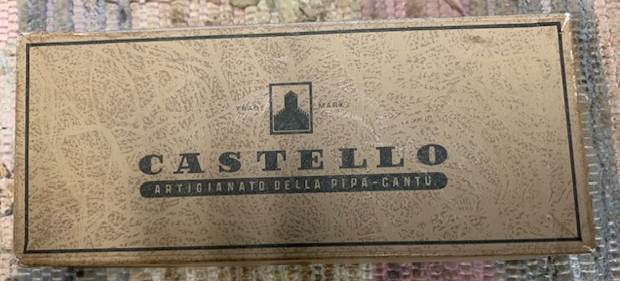

 I took the pipe out of the box and turned it over in my hands. It was in pretty good condition. This is what I saw
I took the pipe out of the box and turned it over in my hands. It was in pretty good condition. This is what I saw
- The finish was dusty and dirty in the grooves and valleys of the finish. Otherwise the finish looked very good.
- The rim top and edges were clean – just dusty. There was no lava build up in the rustication on the rim top and the inner and outer edges of the bowl were clean and undamaged.
- There was a light cake in the bowl. It held the aroma of the tobaccos smoked in it but fortunately they were not aromatic. The walls looked to be undamaged but once I reamed it I would know more about that.
- The acrylic oval taper stem is a variegated brown with a “diamond” logo on the left side. It is stamped Castello Cantu Italy and a 3 on the underside. There is light tooth chatter on both sides but no deep tooth marks.
To summarize what I saw – this Castello is a well made pipe as to be expected. It is dusty but otherwise in good condition. The acrylic stem is lightly marked but otherwise undamaged. The look and feel of the pipe is great in the hand and the rustication is rugged and beautiful. It is going to clean up very well. Here are photos of the pipe before I started my clean up. What do you see when you examine it?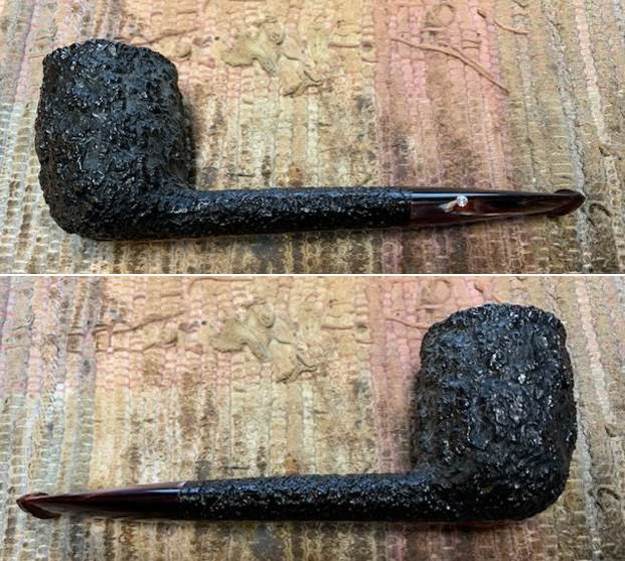
 The bowl of the pipe looked very good. The rustication is clean other than dust – no lava build up. The edges of the bowl were undamaged and looked very good. I see no warning signs in the rim top or the edges of the bowl. I took photos of the acrylic stem to show its condition. Though hard to see there are light tooth marks and chatter on the surface of both sides ahead of the button but it should clean up easily with sandpaper.
The bowl of the pipe looked very good. The rustication is clean other than dust – no lava build up. The edges of the bowl were undamaged and looked very good. I see no warning signs in the rim top or the edges of the bowl. I took photos of the acrylic stem to show its condition. Though hard to see there are light tooth marks and chatter on the surface of both sides ahead of the button but it should clean up easily with sandpaper.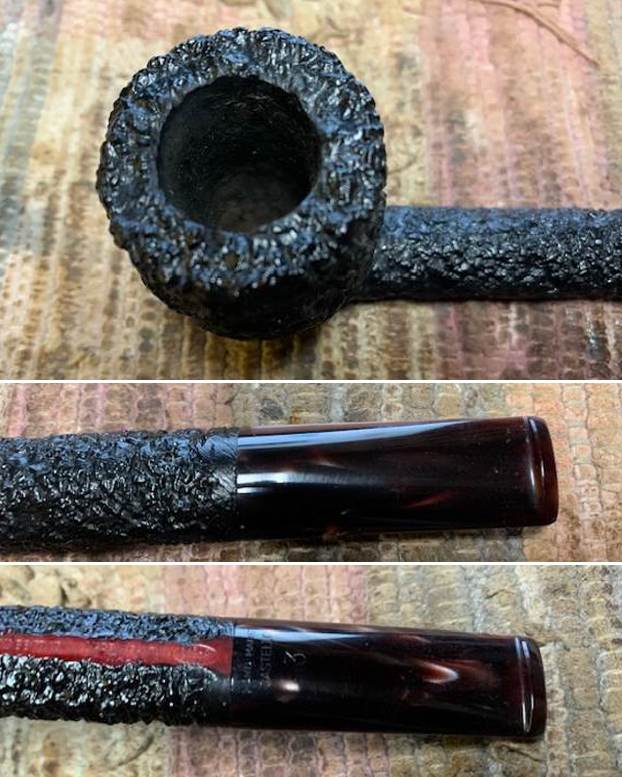 The next photo captures the stamping on the underside of the shank. They read as I have noted above.
The next photo captures the stamping on the underside of the shank. They read as I have noted above. The acrylic/Lucite stem was in excellent condition. It was dirty and had light tooth chatter but no deep tooth marks in the stem surface. The Castello “Diamond” on the left side of the shank is quite nice and undamaged. With the stem sitting next to the shank you can see the proportion of the pipe. It really is a beauty.
The acrylic/Lucite stem was in excellent condition. It was dirty and had light tooth chatter but no deep tooth marks in the stem surface. The Castello “Diamond” on the left side of the shank is quite nice and undamaged. With the stem sitting next to the shank you can see the proportion of the pipe. It really is a beauty.
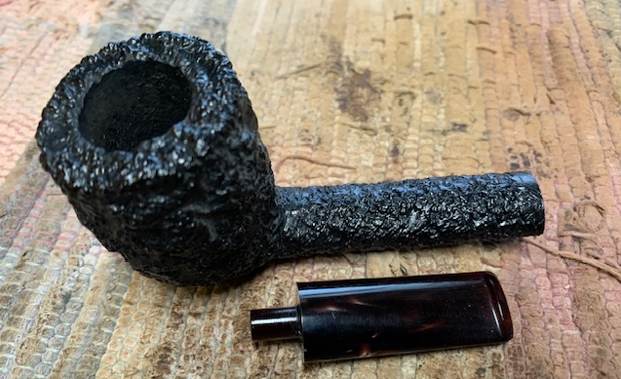 It has been awhile since I had cleaned up a Castello and the Reg. No. and the Carlo Scotti stamp left me with some questions that I need to answer before I began to work on the pipe. I turned first to the Pipephil site (http://www.pipephil.eu/logos/en/logo-castello.html) because of the general quick summary of information I get there. I quote:
It has been awhile since I had cleaned up a Castello and the Reg. No. and the Carlo Scotti stamp left me with some questions that I need to answer before I began to work on the pipe. I turned first to the Pipephil site (http://www.pipephil.eu/logos/en/logo-castello.html) because of the general quick summary of information I get there. I quote:
Castello PIPA CASTELLO di Carlo Scotti & C. was founded in 1947 by Carlo Scotti († 1988). Franco Coppo (AKA “Kino”) who married Carlo Scotti’s daughter Savina, manages (2012) the corporate since 1985.
The site also gave a good summary of the grading and sizes of the pipes. I quote that in full.
Sizes (ascending):
1K to 4K, G (Giant) and GG (Extra large)
Rusticated grading: SEA ROCK, OLD SEA ROCK, NATURAL VIRGIN,
Sandblasted grading: ANTIQUARI, OLD ANTIQUARI
Smooth grading (ascending): TRADEMARK, CASTELLO, COLLECTION
Other stampings: Great Line (Non-standard or freestyle) Fiammata (Straight grain)
Production (2012): ~4000 pipes / year
I also found a note on the page that the Rhinestone logo was originally on pipes for the US market. It is occasionally used now.
I turned then to Pipedia for more information on the brand (https://pipedia.org/wiki/Castello). The majority of the information was what was already quoted above in abbreviated form. However there was a link to an article by Bob Hamlin that gave some interesting bits of information that I found helpful (http://www.pipes.org/BURST/FORMATTED/196.016.html). I quote in part from that article.
SEA ROCK [Carved Black or dark brown]: This is the lowest grade of the Castello line and is the most common in the USA. Sea Rocks are produced by taking a smooth bowl that has not been “final finished” and surface carving the finish with tools. This “carved” finish is then evened out using a steel wire brush, stained and then waxed. The Natural Vergin carved finish is left unstained and unwaxed as a rule, although we have seen waxed and partially waxed “Vergins”.
All carved Castello pipes are graded by the number of K’s that are stamped on each piece and are K-graded by SIZE. 1K is the smallest and fairly rare, 2K is small to medium, with 3K or 4K being the most common and ranges from medium to medium large. Large pieces are stamped “G” for giant and extra large pieces are stamped “GG” for double giant. In addition to the number of K’s on a carved Sea Rock piece the shape number is almost always added. As a rule a Sea Rock Castello is stained Black, although recently there have been quite a few coming in stained deep brown and still stamped “Sea Rock”. American Logo’d Sea Rocks are all priced the same to the consumer, although most are 2 or 3 K’ed models. G/GG models are charged at a higher price on American pieces and are basically the same as their European counterparts.
The Castello Sea Rock briar I was working on did not have the K stamping. It definitely was made for the American Market with the Rhinestone in the stem. It had the black finish. The shape number still needed to be determined.
Pipedia also gave a link to Mike’s Briar Blues site for help in dating and determining shapes (http://www.briarblues.com/castello.htm). I quote a piece on the Reg. No. that I found helpful.
1947 – Carlo Scotti begins the company. In the beginning ( 1947 – 1949, maybe 1950 ) the pipes were stamped Mi Reserva ( my reserve ). Later the Reg No was added. This Reg No has nothing to do with shape numbers, but is merely the Castello company trademark…
Shape numbers. Shape numbers are all 2 digits. A 2 in front indicates a “fancy” interpretation, a 3 in front means that the carving is somehow unique. I don’t know when the change was made, but currently, a π symbol is used instead of the 3xx. I’ve only seen this on Sea Rocks, but that doesn’t mean anything…
Pre K grading. Late 1950’s to mid 1960’s the pipe carried stamps which indicated sizes. These were as follows; SA, SB, SC, and SS. SA being the smallest and SS the largest.
Now I had more information to work with. The Castello in my hands was pre K graded. That told me that it came out in the late 1950s to mid 1960s. The SS stamp makes it the largest sized pipe from that time period. The number 32 makes it a Canadian with an oval shank and acrylic stem.
Armed with that information and renewing my knowledge of the brand it was time to work on the pipe. I started my work on the pipe by cleaning the internals. The cake was quite thin but it can hold residual oils from previous tobaccos and I wanted to check the bowl walls for burn damage or checking. I reamed it with a Savinelli Fitsall Pipe knife and took the cake back to bare briar. I sanded the walls with 220 grit sandpaper wrapped around a piece of dowel. I worked on them until they were smooth. There was no checking or burn damage to the bowl walls. It was quite clean. I cleaned out the internals of the shank and the airway in the stem with 99% isopropyl alcohol, cotton swabs and pipe cleaners. I worked them over until they were clean.
I cleaned out the internals of the shank and the airway in the stem with 99% isopropyl alcohol, cotton swabs and pipe cleaners. I worked them over until they were clean.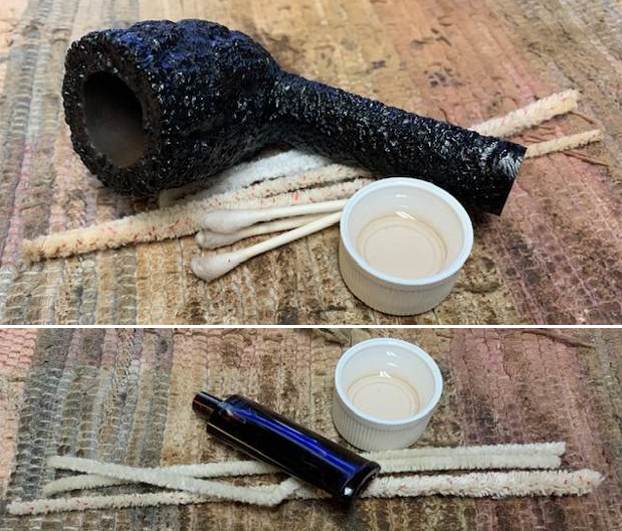 I scrubbed the externals of the bowl and shank with undiluted Murphy’s Oil Soap and a tooth brush. I worked the soap into the grooves and valleys in the finish. I rinsed it off with warm running water. I dried it with a soft cotton towel. The bowl looks much better at this point in the process of recovery.
I scrubbed the externals of the bowl and shank with undiluted Murphy’s Oil Soap and a tooth brush. I worked the soap into the grooves and valleys in the finish. I rinsed it off with warm running water. I dried it with a soft cotton towel. The bowl looks much better at this point in the process of recovery.
 I worked some Before & After Restoration Balm into the rusticated Sea Rock finish on the bowl and the rim top. I worked it into the surface of the briar with my fingertips to clean, enliven and protect the wood. I used a horse hair shoe brush to work it into the crevices and keep from building up in the valleys and crevices of the finish. Once the bowl was covered with the balm I let it sit for about 15 minutes and buffed it off with a soft cotton cloth and the shoe brush. I polished it with a microfiber cloth. I took photos of the pipe at this point in the process to show what the bowl looked like at this point.
I worked some Before & After Restoration Balm into the rusticated Sea Rock finish on the bowl and the rim top. I worked it into the surface of the briar with my fingertips to clean, enliven and protect the wood. I used a horse hair shoe brush to work it into the crevices and keep from building up in the valleys and crevices of the finish. Once the bowl was covered with the balm I let it sit for about 15 minutes and buffed it off with a soft cotton cloth and the shoe brush. I polished it with a microfiber cloth. I took photos of the pipe at this point in the process to show what the bowl looked like at this point.

 I set the bowl aside and worked on the stem. I sanded out the chatter and tooth marks with 220 grit sandpaper. I was able to remove the marks from the surface very well, leaving behind no sign of the tooth damage. I started polishing the stem surface with 600 grit wet dry sandpaper.
I set the bowl aside and worked on the stem. I sanded out the chatter and tooth marks with 220 grit sandpaper. I was able to remove the marks from the surface very well, leaving behind no sign of the tooth damage. I started polishing the stem surface with 600 grit wet dry sandpaper. I dry sanded both sides of the stem with 1500-12000 grit pads to polish it further. I wiped it down with a damp cloth after each sanding pad. The shine grew deeper with each sanding pad.
I dry sanded both sides of the stem with 1500-12000 grit pads to polish it further. I wiped it down with a damp cloth after each sanding pad. The shine grew deeper with each sanding pad.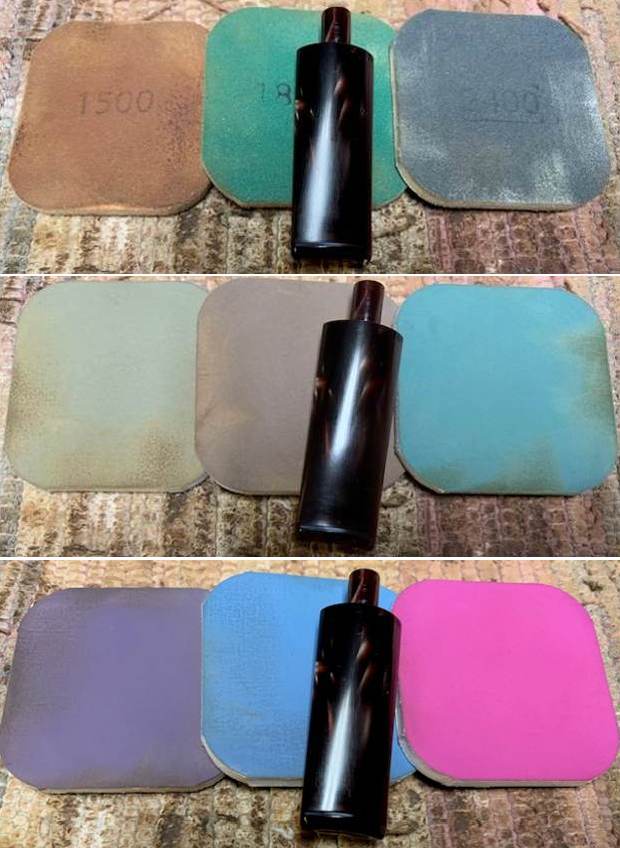 I finished polishing the stem with Before & After Pipe Polish – both Fine and Extra Fine polishes. I wiped the stem down with a damp cotton pad afterwards and buffed it with a soft microfiber cloth.
I finished polishing the stem with Before & After Pipe Polish – both Fine and Extra Fine polishes. I wiped the stem down with a damp cotton pad afterwards and buffed it with a soft microfiber cloth.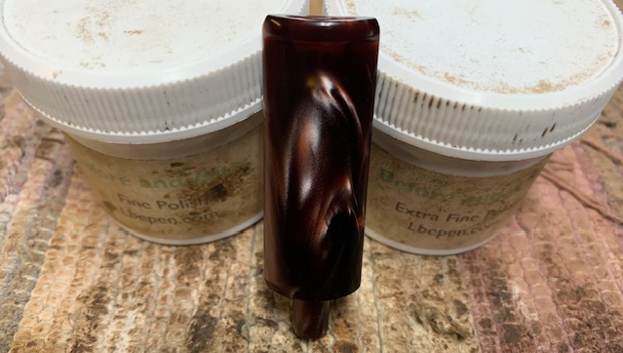 I put the bowl and stem back together. I don’t buff the rusticated bowl on the wheel as it leaves a lot of grit in the deep grooves of the rustication. I gave the bowl and shank multiple coats of Conservator’s Wax and buffed it with a shoe brush to raise the shine. The wax is great protection and I love using it on rusticated and sandblast finishes because it does not build up in the grooves and valleys like carnauba wax does. I buffed it by hand with a microfiber cloth to finish the shine.
I put the bowl and stem back together. I don’t buff the rusticated bowl on the wheel as it leaves a lot of grit in the deep grooves of the rustication. I gave the bowl and shank multiple coats of Conservator’s Wax and buffed it with a shoe brush to raise the shine. The wax is great protection and I love using it on rusticated and sandblast finishes because it does not build up in the grooves and valleys like carnauba wax does. I buffed it by hand with a microfiber cloth to finish the shine.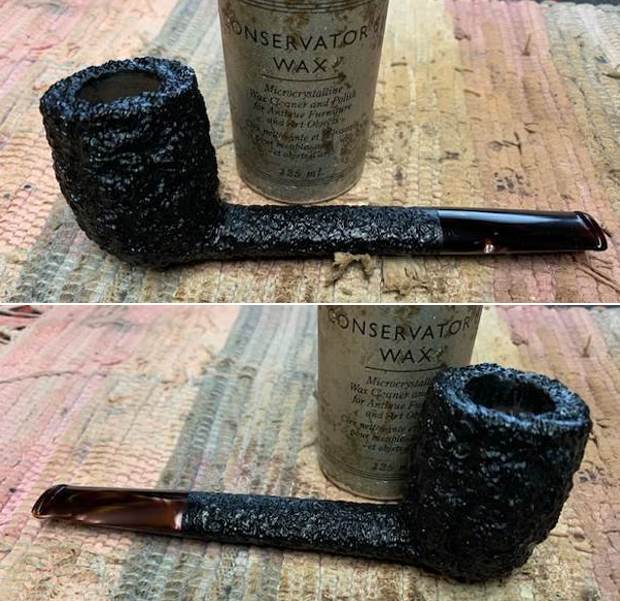
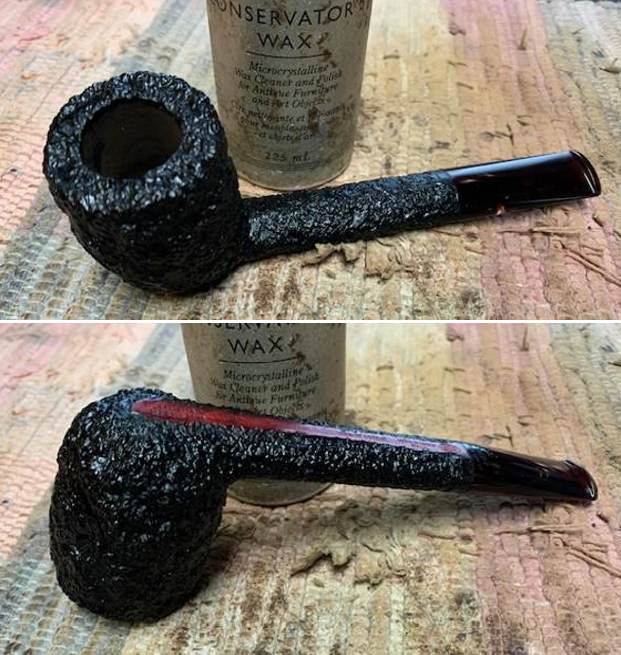 I polished the stem with Blue Diamond on the buffing wheel to polish out the scratches in the Lucite. I buffed the pipe with a clean buffing pad to raise the shine. I hand buffed it with a microfiber cloth to deepen the shine. The pipe polished up pretty nicely. The contrast of the blacks and dark browns of the briar with the shine of the polished variegated brown acrylic/Lucite is quite stunning. The dark and coral like rustication around the bowl and shank is quite remarkable and gives the pipe an incredible tactile presence. This is truly a beautiful pipe and one that will give the next pipe man or woman a great smoking pipe that will outlast them. The finished pipe is shown in the photos below. The dimensions of the pipe are Length: 5 ¾ inches, Height: 2 inches, Outside diameter of the bowl: 1 ½ inches, Chamber diameter: 3/4 of an inch. The weight of the pipe is a light and comfortable 55 grams/1.94 ounces. I have a few Castellos in my collection that have come to me in a variety of ways. They have all been beautiful pipes and the look of this Canadian Sea Rock should be the same kind of smoker. I will be putting it on the rebornpipes store in the Italian Pipe Makers Section soon. If you want to add it your rack let me know. Thanks for walking through the restoration with me. Cheers.
I polished the stem with Blue Diamond on the buffing wheel to polish out the scratches in the Lucite. I buffed the pipe with a clean buffing pad to raise the shine. I hand buffed it with a microfiber cloth to deepen the shine. The pipe polished up pretty nicely. The contrast of the blacks and dark browns of the briar with the shine of the polished variegated brown acrylic/Lucite is quite stunning. The dark and coral like rustication around the bowl and shank is quite remarkable and gives the pipe an incredible tactile presence. This is truly a beautiful pipe and one that will give the next pipe man or woman a great smoking pipe that will outlast them. The finished pipe is shown in the photos below. The dimensions of the pipe are Length: 5 ¾ inches, Height: 2 inches, Outside diameter of the bowl: 1 ½ inches, Chamber diameter: 3/4 of an inch. The weight of the pipe is a light and comfortable 55 grams/1.94 ounces. I have a few Castellos in my collection that have come to me in a variety of ways. They have all been beautiful pipes and the look of this Canadian Sea Rock should be the same kind of smoker. I will be putting it on the rebornpipes store in the Italian Pipe Makers Section soon. If you want to add it your rack let me know. Thanks for walking through the restoration with me. Cheers. 